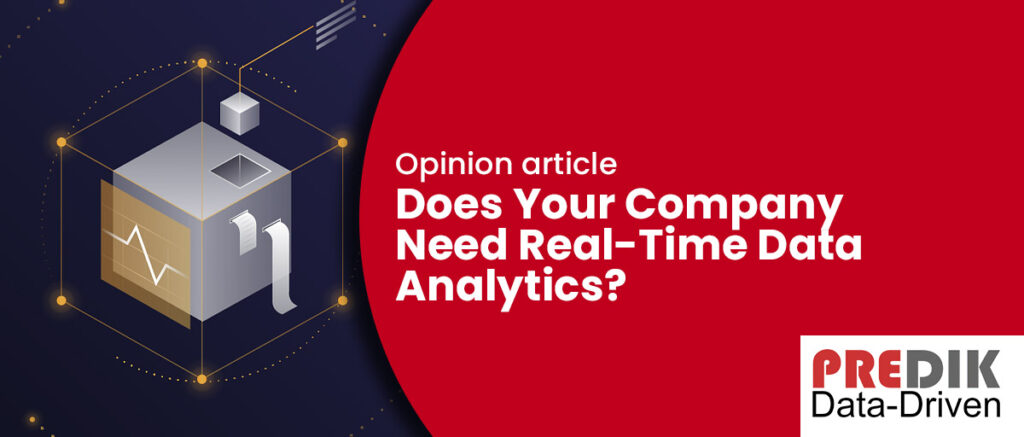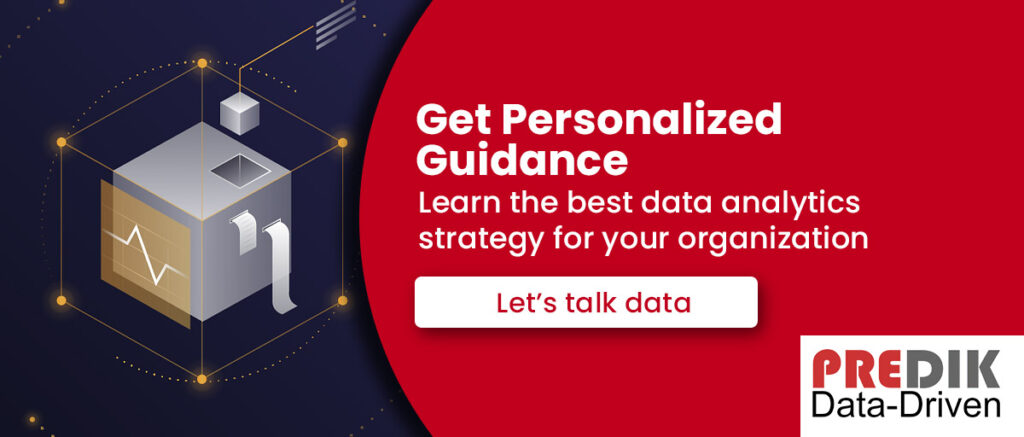Real-time analytics and insights are often cited as one of the main advantages of Big Data. Real-time data has become a buzzword among data blogs, implying that companies not using it are missing out on a significant portion of the potential benefits in a data-driven era.
The premise is appealing. Real-time data can help organizations make decisions faster, increasing their ability to optimize key processes and strategies and detecting issues early. That is true.
But there is also another truth. Most companies are not at a stage that requires having this kind of data. In fact, in recent years, we have worked with over a dozen projects involving highly complicated Business Intelligence solutions based on Machine Learning (ML) and Artificial Intelligence. Guess what? None of them needed real-time data.
This article is part of a series in which we include the point of view of our analysts on topics related to Data Science and Big Data. This content reflects the expert opinion of our Data Analyst, Álvaro Bermejo.
Before we continue…What is real-time data?
Basically, real-time data is immediately available post-collection, ensuring timely information provision.
“…data that is not kept or stored, but is passed along to the end user as quickly as it is gathered.”
Techopedia
This data can come from different sources, such as sensors, cameras, social media feeds, websites, data streaming, and customer service systems. Once collected, it requires processing and analysis to be helpful. Then, analytics teams use multiple techniques and tools to achieve this, such as streaming data processing and ML.
Usually used for navigation and tracking, real-time data can be dynamic (e.g., a variable indicating current location) or static (e.g., a fresh log entry indicating location at a specific time).
The pros and cons of real-time data
As good as real-time data might sound for your organization, you must consider some cons and pros before deciding if it suits your business strategy.
Pros of real-time data
Suitable for quick analysis and immediate decision-making. Real-time data can be beneficial when you need information quickly without processing it. For instance, a logistics company can analyze data directly taken from their fleet sensors to make corrections to their route planning based on weather or traffic conditions.
Enhanced customer experiences. Real-time data can help businesses better understand their customers and provide them with more personalized experiences. For example, a retail company could use it depending on their purchase patterns.
Increased operational efficiency: With the boom of Industry 4.0, real-time data have become an option for big industrial companies that must identify and address their operations’ bottlenecks and inefficiencies as soon as possible.
Cons of real-time data
Not suitable for deep analysis. Deep and complex analysis needs processing time, data enrichment, and sometimes even historical data. So, the “real-time” element will not be necessary.
It is expensive to collect real-time information. Real-time data systems can be complex and costly to implement and maintain, even when working with external providers.
Isolated data points. Usually, this data cannot be compared or complemented with other data points (Like historical data). Why? Again, it will take time to do it.
| Pros of real-time data | Cons of real-time data |
|---|---|
| Suitable for quick analysis and immediate decision-making | Not suitable for deep analysis |
| Enhanced customer experiences | It is expensive to collect real-time information |
| Increased operational efficiency | Isolated data points |
So, when to use real-time analytics? And when not?
The best time to use real-time data is when decision-making time is the most crucial factor within your organization. This includes situations where:
- You need to respond to changes in your system within a very short period.
- You have a business need to make decisions quickly, such as in fraud detection or risk management.
- You need to track customer interactions and identify potential problems in real-time.
- You need to monitor and optimize operational processes as soon as possible.
Also, real-time data analysis has proven helpful in the following scenarios:
- Anything involving a sensor working non-stop. For example, environmental data (temperature, pressure, noise). This could be used to assess natural hazards.
- Customer journey mapping. As customers move within a website or from one channel to another, real-time data can provide valuable insights to understand their needs and secure conversion.
- Trends and pricing monitoring. Real-time analytics helps companies (Especially investment firms) that need to track elements that could change the price or availability of a product.
On the other hand, real-time data analytics might not be necessary if your business doesn’t require quick decision-making, has a limited data analytics budget, or can be fulfilled with a batch processing system.
Also, this data is not applicable when you need data aggregations, like understanding your average visitor or trip duration.
“… if managing sales accounts where every last sales contract takes months to land, and contracts last for years, it’s going to be extremely unlikely that you’re going to benefit for a low latency analytics system.”
Towards Data Science
It is essential to balance the need for speed with the cost of implementing a real-time data analytics system. Remember, real-time data analytics systems can be expensive, so ensuring that the benefits outweigh the costs is vital.
Furthermore, consider that not all data is available in real-time. For example, data from financial transactions may not be available in real-time due to processing delays.
We recommend you reading: Is Your Company Data-Driven? (Let’s Find Out)
Have you heard about near real-time data?
Near real-time data is processed and analyzed within minutes of being generated. This is faster than batch processing, which may take hours or even days to process data.
| Data type | When to use it? |
|---|---|
| Real-time | When you need information insights immediately (Within seconds). |
| Near real-time | When speed is key, but you don’t need it immediately (Within minutes). |
| Batch | When you can wait for days (or longer) for processing a more in-depth anaylsis. |
Near real-time data works well when speed is essential, but processing time in minutes is acceptable. Some examples can be:
- Processing sensor data from devices such as IoT devices or medical devices.
- Monitoring IT systems for performance issues or security threats.
- Processing financial transactions to detect fraud or prevent money laundering.
Near real-time data can also produce operational intelligence meant to identify opportunities in the data (such as sales leads) and threats (detecting an intruder in the network).
One example of near real-time data processing is the monitoring of financial transactions. To detect fraud, a bank may want to monitor financial transactions in “near” real-time.
Final thoughts
Technological considerations alone should not be the only factor when deciding whether to upgrade analytics infrastructure for faster data processing.
It is important to consider the organizational structure and culture of your business. Is your company willing and able to change to use faster data processing? Are there people in place who understand how to use the data to make decisions and change processes to match?
If your business is not ready to use faster data processing, then upgrading your analytics infrastructure may not be a wise investment. It may even be a distraction.
Now, if you decide to upgrade your analytics infrastructure, you should also budget for training on using the new system, outsourcing datasets, and interpreting the information it produces.
Overall, the decision to use real-time or near-real-time data systems involves both technical and business considerations.



